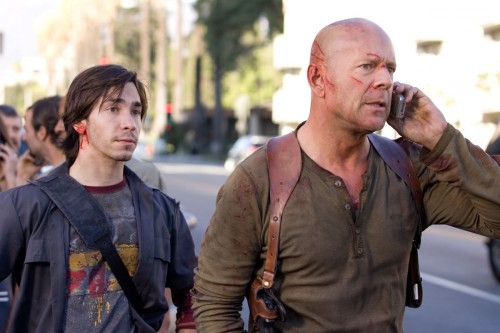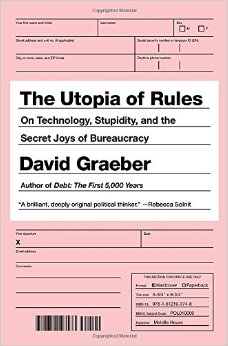
David Graeber has republished his popular essay Of Flying Cars and the Declining Rate of Profit in his new book Utopia of Rules with some small changes that go toward supporting the book’s over-all argument that the hallmark of American neoliberalism is not dynamism and a freeing up of individuals to peruse “creative class” jobs but rather a bureaucratization of every aspect of life. This total bureaucratization (almost literally) papers over the structural violence that supports capitalism. Of Flying Cars specifically argues that the utter failure to deliver on the implicit promises of Jetsons-level automation by the 21st century is not necessarily a matter of market forces (no one actually wants a flying car!) or technical impossibility (Moore’s law hasn’t delivered thinking computers yet!) but is in fact a product of both squashing the imagination through bureaucratic devices, and the immense devaluing of labor and elimination of corporate profit taxation that leads to paltry civilian research and development. In essence, capitalism in its present form, is anathema to the future it once promised.
Graeber states in the beginning of the essay that he is puzzled by the near silence from those people who saw the moon landing on their televisions but today do not, themselves, live on the moon (or can easily teleport there, or take a drug that might extend their life to the time that both of those things are available). “Instead,” he writes, “just about all the authoritative voices—both on the Left and Right—began their reflections from the assumption that a world of technological wonders had, in fact, arrived.”
Graeber relatively quickly drops the issue of how our collective expectations of the future could be so quickly and completely re-aligned (his answer is postmodernism) and goes on to explain why such an alignment has become necessary (capitalism’s secret love of bureaucracy) but I want to dwell on the “how” question a little bit longer by offering up a corollary to Of Flying Cars. The argument that follows is also a reprinting of my own work, an article published in a 2012 issue of the International Journal of Engineering Social Justice in Peace, co-authored with Arizona State University’s Joseph R. Herkert. I want to argue that our expectations for the future are purposefully managed through a circulation of imagined threats to capitalism, the popularizing of narratives that flesh out that threat, and the re-articulation of those imagined threats as real ones that must be met with massive government funding. I will demonstrate this process using a beloved and uniquely American franchise: Die Hard.
The original article, available in full here, argued that the top-down technocratic perspective exemplified by Robert Moses’ demolishing of vast swaths of New York City are still alive and well today, but are repackaged in Silicon Valley platitudes of disruption and hacking that circulate in popular media so as to 1) provide the technocrat’s view of the world as an inevitable future, 2) drum up support for a clearly unethical approach to technological development by establishing narratives that reaffirm the need for the technocratic view, and 3) establish popular touchstones that make small areas of research that benefit an elite few appear to be global needs on the scale of clean water or sanitation.
We argued that in past iterations of this process, companies like GM and Ford offered positive views of the future through (among other marketing campaigns) their exhibits at the 1939 and 1964 world’s fairs that gave out pins to visitors that read “I have seen the future!” Today’s expectation management is different in that rather than plainly state “this is the future we will create” our media describes future development as merely a response to seemingly uncontrollable events such as terrorism or resource scarcity. This is where my previously published work on Die Hard comes in.
The Die Hard franchise is notable, among other reasons, for the variety of its source material. The first two movies were based on paperback action novels published in the mid to late 1980s. The third installment, Die Hard: With a Vengeance, was adapted from an orphaned screenplay titled Simon Says. The fourth movie, Live Free or Die Hard, however, is a radical departure from the prior three. Live Free is based on a WIRED Magazine article, “A Farewell to Arms,” in which John Carlin describes the U.S. military’s preparations for “I-war”. Carlin quotes the Chinese military newspaper, Jiefangju Bao, for a summary of I-war. It reads, in part:
After the Gulf War, when everyone was looking forward to eternal peace, a new military revolution emerged. This revolution is essentially a transformation from the mechanized warfare of the industrial age to the information warfare of the information age. Information warfare is a war of decisions and control, a war of knowledge, and a war of intellect. The aim of information warfare will be gradually changed from “preserving oneself and wiping out the enemy” to “preserving oneself and controlling the opponent.”
Live Free is about control: the control of people, resources, institutions, and (most importantly) infrastructure. The plot revolves around a spurned government cyber-security official named Thomas Gabriel, who carries out the mythical “fire sale” cyber security breach. The “fire sale” is named as such because, just like the eponymous inventory clearance event, “everything must go.” Mass media, financial systems, and infrastructure are all compromised and brought under the control of Gabriel’s small army of hackers and mercenaries. They are only able to accomplish such a feat by anonymously soliciting outside hackers to write viruses under the auspices of a corporate computer security firm. Once the viruses have been written, Gabriel orders all of the hackers killed. John McClane (played by Bruce Willis) saves one of the hackers, Matthew Farrell (played by Justin Long), just as the assassin team arrives at his apartment. The rest of the movie follows Farrell and McClane as they attempt to thwart the massive attack on America’s computer-run infrastructure.
The two characters’ perspectives on technology are representative of mass media’s imposed narratives on the “generation gap” between so-called millennials and baby boomers. Technology, as it appears to Farrell (the millennial), improves individuals’ lives; society is an afterthought. McClane (the boomer) has come to recognize that there is no technological white knight that will end hunger or disease. His technological optimism-turned pragmatic idealism is representative of his fellow baby boomers who, just as they are reaching retirement, find the social safety net in tatters. Institutions are corrupt and inept, and technology is just as alienating as it is tragically flawed. This tension is perfectly demonstrated in two scenes.
In the first scene, McClane is escorting Farrell to a police precinct just as the “Fire Sale” begins. Gabriel calls McClane and offers him a tradeoff similar to actual U.S. fiscal policy: by sacrificing the millennial, McClane’s debt will be eliminated and his own millennial children will be “set for life.” Gabriel makes this offer only after emptying McClane’s retirement fund as a demonstration of his power. McClane declines the offer and (by way of machine-gun-equipped black helicopter) is immediately denied by Gabriel the relative safety of his cop-filled SUV. This makes for an interesting comparison to the 90s era installment With a Vengeance, wherein an equally decade-appropriate offer is made to McLane: a dump truck full of inflation-resistant gold bullion stolen from the Federal Reserve Bank of New York.
The second scene comes just as the full effects of the Fire Sale have become clear. Farrell, recognizing his own latent desire for wanton destruction of “the system,” prompts a frank discussion of what is at stake:
Farrell: This is virtual terrorism.
McClane: What?
Farrell: You know, first time I heard about the concept of a fire sale . . . I actually thought it would be cool if anyone ever did it. Just hit the reset button and melt the system just for fun.
McClane: Hey, it’s not a system; it’s a country. You’re talking about people, all right? A whole country full of people. Sitting at home alone scared to death in their houses, all right? So if you’re done with your little nostalgic moment and think a little bit and help me catch these guys, just help me. Just put yourself in their shoes.
This exchange between McClane and Farrell mirrors the Faustian bargain demanded by technocrats and bureaucrats: if you take any interest in technological development that does not conform to the grand narrative of progress (such as hitting the “reset button”), you are co-signing your fellow Americans to a short life of Hobbesian terror. The young radical and the skeptical citizen alike pose a danger to everyone’s collective livelihood simply by making rhetorical room for alternative conceptions of progress. Meanwhile, the “old national faith in the advancement of technology as a basis for social progress,” to quote Leo Marx, not only keeps McClane (and the sympathetic audience) loyal to this sociotechnical regime, but it translates a system of pipes and cables into a nation.

Graeber concludes his Of Flying Cars chapter by observing that:
…ultimately, claims for the present-day inevitability of capitalism have to be based on some kind of technological determinism. And for that very reason, if the ultimate aim of neoliberal capitalism is to create a world where no one believes any other economic system could really work, then it needs to suppress not just any idea of an inevitable redemptive future, but really any radically different technological future at all.
What I have provided is a very specific mode by which our expectations of possible technological futures are managed through popular culture. There is a pervasive notion, exemplified by the scenes in Live Free or Die Hard that I just described, that any rebellion against these expectations are immature desires that could lead to collateral damage. But how, specifically, does this sort of culture work influence actually existing research and development?
The article Herkert and I wrote was part of an issue dedicated to critiquing the National Academy of Engineer’s Grand Challenges For Engineering, a document meant to set the tone for future investment in applied science and technology research and development. It lists several major areas of future research that grant writing institutions should fund if society is to meet some of its biggest 21st century challenges. For the most part it is a fairly stern and dry document until you reach the section titled “secure cyberspace” which reads in part:
Electronic computing and communication pose some of the most complex challenges engineering has ever faced. They range from protecting the confidentiality and integrity of transmitted information and deterring identity theft to preventing the scenario recently dramatized in the Bruce Willis movie “Live Free or Die Hard,” in which hackers take down the transportation system, then communications, and finally the power grid.
Rarely is the cycle of imagined threats, popularized threats, and constructed futures so blatant but I’m sure there are hundreds more examples lurking out there. This sort of dynamic makes it difficult to remember that our expectations of what the future will look like, and what sort of planetary social order will provide that future, are of our choosing. It also means that pop culture, as many before me have argued, is far from trivial. It is, perhaps, our best hope for steering the future course of technological development.
David is on Twitter and Tumblr.
Note on authorship: The section between the two horizontal lines are a slightly altered reprint of a section of Herkert, Joseph R, and David A Banks. “I Have Seen the Future!: Ethics, Progress, and the Grand Challenges for Engineering.” International Journal of Engineering, Social Justice, and Peace 1, no. 2 (2012): 109–22. Used under a Creative Commons Attribution 3.0 License that allows others to share the work with an acknowledgement of the work’s authorship and initial publication in this journal. Full text available here: http://library.queensu.ca/ojs/index.php/IJESJP/article/view/4306
